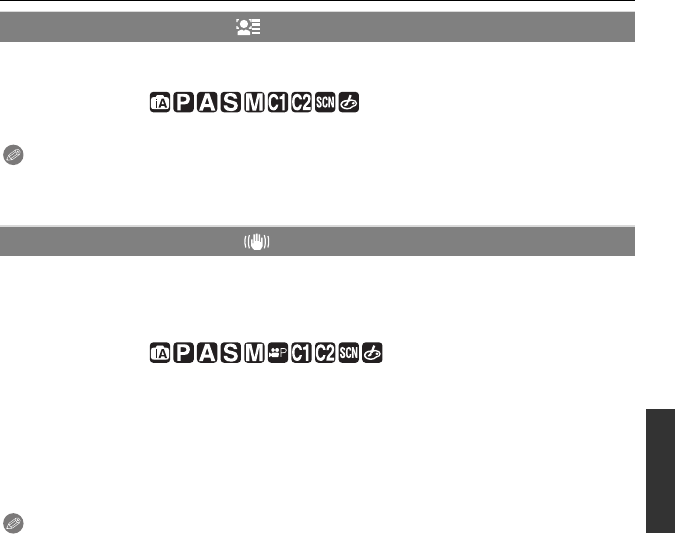
117
VQT2G44
Advanced (Recording pictures)
For details on [REC] mode menu settings, refer to P28.
Specify a person’s face and use the face recognition functions.
Applicable modes:
[OFF]/[ON]/[MEMORY]/[SET]
Note
• Refer to P105 for details.
For details on [REC] mode menu settings, refer to P28.
Using one of these modes, jitter during picture taking is detected, and the camera
automatically compensates the jitter, enabling jitter-free images to be taken.
Check that the [O.I.S.] switch on the lens is set to [ON]
¢
.
Applicable modes:
Note
¢A lens which supports the Stabilizer function is required.
– The 20 mm/F1.7 interchangeable lens supplied with the DMC-GF1C does not support the
stabilizer function.
– The 14-45 mm/F3.5-5.6 interchangeable lens supplied with the DMC-GF1K supports the
stabilizer function.
• [STABILIZER] cannot be selected when a lens without Stabilizer function is used.
• The stabilizer function may not be effective in the following cases.
– When there is a lot of jitter.
– When the zoom magnification is high.
– When using the digital zoom.
– When taking pictures while following a moving subject.
– When the shutter speed becomes slower to take pictures indoors or in dark places.
• Be careful of camera jitter when you press the shutter button.
• The panning effect in [MODE3] is more difficult to achieve in the following cases.
– In brightly lit places such as in broad daylight on a summer’s day
– When the shutter speed is faster than 1/100th of a second.
– When you move the camera too slowly because the subject is moving slowly. (The
background will not become a blur.)
– When the camera does not keep up with the subject satisfactorily
• We recommend taking pictures with the Optional External Viewfinder (P159) when panning in
[MODE3].
• The setting is fixed to [MODE1] in recording motion pictures.
[FACE RECOG.]
[STABILIZER]
[MODE1]: Jitter is always compensated during [REC] mode.
[MODE2]: The jitter is compensated for when the shutter button is pressed.
[MODE3]: Camera shake is corrected for up/down movements. This mode is ideal for
panning (a method of taking pictures which involves turning the camera to
track the movements of a subject which continues to move in a fixed
direction).
DMC-GF1KPP-VQT2G44_eng.book 117 ページ 2009年8月17日 月曜日 午後1時19分


















